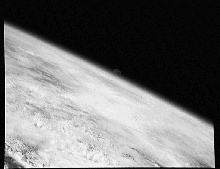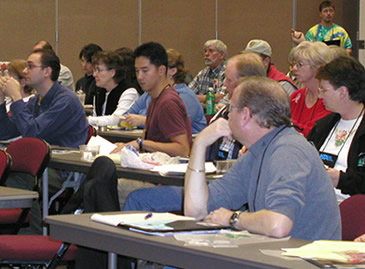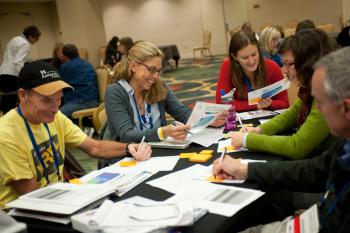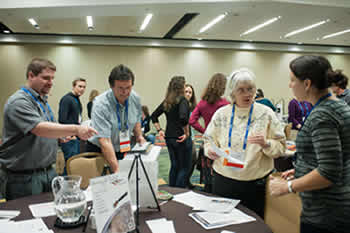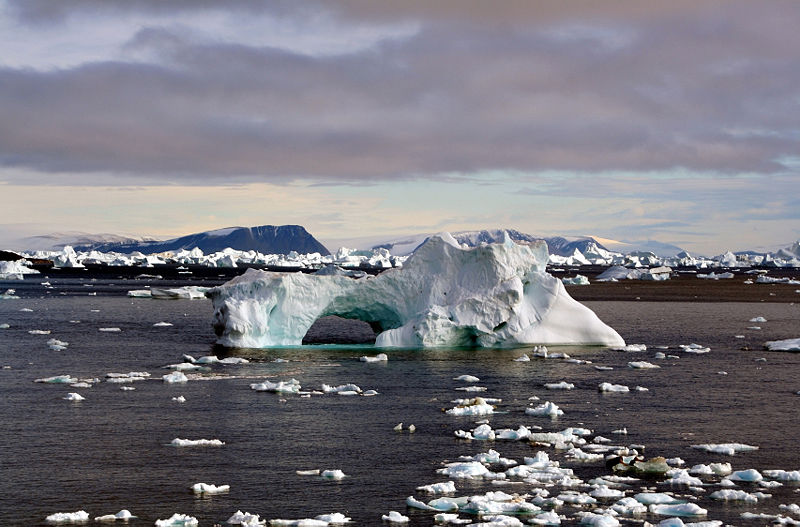Giant Impact Theory of the Origin of the Moon
This article summarizes calculations that simulate what may have been the most violent event that has ever occurred to the Earth, its collision with the next largest body that was present in its region of accumulations in the early Solar System. This body was a planet in its own right, an object somewhat more massive than the planet Mars. The collision would have created a disk of molten and gaseous debris in orbit around the protoearth. Dissipation of this disk may have resulted in the formation of the Moon.
Curiosity about the origin of the Moon played an important part in persuading the National Aeronautics and Space Administration to establish the Apollo project that placed men on the surface of the Moon. At the time, there were three competing theories of the origin of the Moon:
Image from NASA Spacelink
1) Capture Theory.The Moon was formed elsewhere in the Solar System and was captured by the Earth.
2) Formation of the Moon in Orbit Theory.The Moon was formed from material that had been captured into orbit around the Earth after the Earth was mostly formed.
3) Fission Theory.The Earth spun fast enough so that it became deformed and a piece broke off to become the Moon.
As the Apollo project progressed, it became noteworthy that few scientists working on the project were changing their minds about which of these three theories they believed was most likely correct, and each of the theories had its vocal advocates. In the years immediately following the Apollo project, this division of opinion continued to exist. One observer of the scene, a psycholo- gist, concluded that the scientists studying the Moon were ex- tremely dogmatic and largely immune to persuasion by scientific evidence. But the facts were that the scientific evidence did not single out any one of these theories. Each one of them had several grave difficulties as well as one or more points in its favor.
In the mid-1970s, other ideas began to emerge. William K. Hartmann and D.R. Davis (Planetary Sciences Institute in Tucson AZ) pointed out that the Earth, in the course of its accumulation, would undergo some major collisions with other bodies that have a sub- stantial fraction of its mass and that these collision would produce large vapor clouds that they believe might play a role in the formation of the Moon. A.G.W. Cameron and William R. Ward (Harvard University, Cambridge MA) pointed out that a collision with a body having at least the mass of Mars would be needed to give the Earth the present angular momentum of the Earth-Moon system, and they also pointed out that such a collision would produce a large vapor cloud that would leave a substantial amount of material in orbit about the Earth, the dissipation of which could be expected to form the Moon. The GIANT IMPACT THEORY of the origin of the Moon has emerged from these suggestions.
These ideas attracted relatively little comment in the scientific community during the next few years. However, in 1984, when a scientific conference on the origin of the Moon was organized in Kona, Hawaii, a surprising number of papers were submitted that discussed various aspects of the giant impact theory. At the same meeting, the three classical theories of formation of the Moon were discussed in depth, and it was clear that all continued to present grave difficulties. The giant impact theory emerged as the "fashionable" theory, but everyone agreed that it was relatively untested and that it would be appropriate to reserve judgement on it until a lot of testing has been conducted. The next step clearly called for numerical simulations on supercomputers.
The author in collaboration with Willy Benz (Harvard), Wayne L. Slattery at (Los Alamos National Laboratory, Los Alamos NM), and H. Jay Melosh (University of Arizona, Tucson, AZ) undertook such simulations. They have used an unconventional technique called smooth particle hydrodynamics to simulate the planetary collision in three dimensions. With this technique, we have followed a simulated collision (with some set of initial conditions) for many hours of real time, determining the amount of mass that would escape from the Earth-Moon system, the amount of mass that would be left in orbit, as well as the relative amounts of rock and iron that would be in each of these different mass fractions. We have carried out simulations for a variety of different initial conditions and have shown that a "successful" simulation was possible if the impacting body had a mass not very different from 1.2 Mars masses, that the collision occurred with approximately the present angular momentum of the Earth-Moon system, and that the impacting body was initially in an orbit not very different from that of the Earth.
The Moon is a compositionally unique body, having not more than 4% of its mass in the form of an iron core (more likely only 2% of its mass in this form). This contrasts with the Earth, a typical terrestrial planet in bulk composition, which has about one-third of its mass in the form of the iron core. Thus, a simulation could not be regarded as "successful" unless the material left in orbit was iron free or nearly so and was substantially in excess of the mass of the Moon. This uniqueness highly constrains the conditions that must be imposed on the planetary collision scenario. If the Moon had a composition typical of other terrestrial planets, it would be far more difficult to determine the conditions that led to its formation.
The early part of this work was done using Los Alamos Cray X-MP computers. This work established that the giant impact theory was indeed promising and that a collision of slightly more than a Mars mass with the Earth, with the Earth-Moon angular momentum in the collision, would put almost 2 Moon masses of rock into orbit, forming a disk of material that is a necessary precursor to the formation of the Moon from much of this rock. Further development of the hydrodynamics code made it possible to do the calculations on fast small computers that are dedicated to them.
Subsequent calculations have been done at Harvard. The first set of calculations was intended to determine whether the revised hydrodynamics code reproduced previous results (and it did). Subsequent calculations have been directed toward determining whether "successful" outcomes are possible with a wider range of initial conditions than were first used. The results indicate that the impactor must approach the Earth with a velocity (at large distances) of not more than about 5 kilometers. This restricts the orbit of the impactor to lie near that of the Earth. It has also been found that collisions involving larger impactors with more than the Earth-Moon angular momentum can give "successful" outcomes. This initial condition is reasonable because it is known that the Earth-Moon system has lost angular momentum due to solar tides, but the amount is uncertain. These calculations are still in progress and will probably take 1 or 2 years more to complete.
GIANT IMPACT THEORY OF THE ORIGIN OF THE MOON, A.G.W. Cameron,
Harvard-Smithsonian Center for Astrophysics, Cambridge MA 02138,
PLANETARY GEOSCIENCES-1988, NASA SP-498


